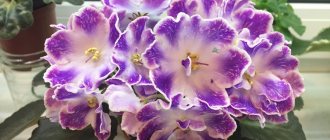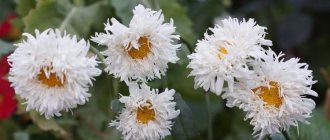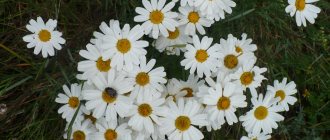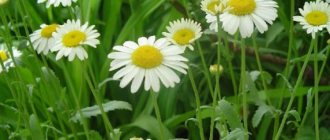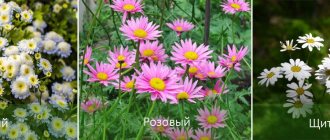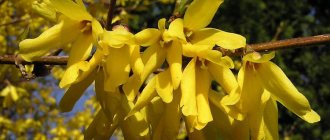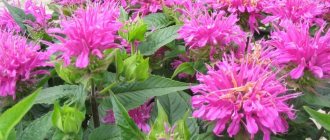Maiden daisy (Tanacetum parthenium, Matricaria parthenium) is a perennial herbaceous plant of the Asteraceae (Asteraceae) family. It is known by several names: "pyrethrum maiden", "matricaria exceptional", "chrysanthemum maiden" and "tanacetum". The species-specific maiden daisy and its lovely garden forms look good. Sometimes a perennial is criticized for being a shameless weed. This is a consequence of the vitality and unpretentiousness of the plant, which grows, blooms and reproduces remarkably even when no one cares for it.
Maiden daisy
Not everyone realizes what a useful plant chamomile is. In the Middle Ages it was called the "mother herb". The name of the plant (Greek parthenos - “maiden”) is most likely due to the fact that maiden chamomile helps with painful menstruation. In those distant times, maiden chamomile was kept in apothecary gardens and monastery gardens as a remedy to help women during childbirth. It was given at high temperatures and fevers as an anti-inflammatory and antipyretic agent.
Maiden's chamomile can also be used on the farm. First of all, as a reliable repellent of natural origin. And how nice it is that openwork bushes with light green foliage remain fresh and sometimes bloom even in the gloomy pre-winter period!
Caring for maiden chamomile
Place. Maiden's chamomile is light-loving, but grows well in partial shade. It is planted in flower beds, flower pots and balcony boxes. Gardeners who favor environmentally friendly methods of pest control can leave a few bushes under garden trees, next to shrubs and in vegetable beds.
The soil. Maiden chamomile has no special predilections for the composition and structure of soils, although luxurious bushes often grow on fertile garden soils. Seedlings of maiden chamomile feel good even between paving slabs, in cracked blind areas, near humus heaps or, unexpectedly for everyone, they end up in flower pots with indoor plants.
Watering. Pyrethrum maiden steadfastly tolerates temporary drought. But prolonged waterlogging is dangerous for him.
Winter hardiness. Maiden's chamomile easily tolerates spring and autumn frosts. In winter, its bushes often do not freeze out, but get wet. Once on our site, in the place where at the end of summer a delicate lawn of numerous young daisy bushes had turned green, in the spring a huge heavy snowdrift did not melt for a long time. When the snow completely melted, it turned out that only a few withered bushes remained from the emerald carpet. I had to clean the area with a rake and sow lawn grass.
Trimming. A maiden chamomile bush will bloom continuously and for a long time if all faded inflorescences are regularly removed. It is easier and faster to cut off the faded top part with garden shears.
Reproduction. Maiden chamomile is replanted even at the moment of flowering. The main thing is to preserve the earthen lump. Dividing adult overgrown bushes is a simple and accelerated propagation option. The seed method is also simple. Especially when the plant itself does this: its self-seeding will appear in a variety of places. Seedlings grow very quickly, they tolerate transplantation well and easily settle into a new place. Flowering begins 80 - 100 days after emergence.
Maiden chamomile bushes grow everywhere
Main diseases and pests of crops and control measures
Field chamomile
Bush garden chamomile gets sick extremely rarely. Most often these are fungal diseases, when a gray coating appears on the leaves of individual plants. In this case, the affected bush should be removed as quickly as possible, and the soil and remaining plants should be treated with a copper fungicide.
Treatment with an insecticide usually helps get rid of all types of parasites. There is also a more natural way - attracting animals such as hedgehogs and birds that like to feast on slugs or insects to your site. Small garden daisies, as pyrethrum is often popularly called, will not cause much trouble to care for, but for a long time they can decorate gardeners’ areas with bright, beautiful flowers.
0 0 votes
Article rating
Varieties of maiden chamomile
The species-specific (that is, the simplest) maiden daisy looks very cute. The inflorescences look like a tiny daisy. Once you rub the bright light green leaves, a sharp but quite pleasant smell appears.
It is easy to create carpet plantings from the native maiden daisy, which can be used to decorate uneven places, tree trunks, and “draw” patterns on lawns. When sowing masses, it is important to prevent the appearance of seeds so that you do not have to fight self-seeding.
Garden forms and varieties of maiden chamomile look great. Unfortunately, there are few of them on sale. This is a low-growing garden variety with golden leaves only 15–20 cm high. There are also tall forms up to 60 cm high, which are suitable for cutting.
There are domestic varieties of maiden chamomile on sale: “Snow Globe”, “Golden Ball”, “Yellow Ball”, mixtures of varieties and several foreign varieties. They differ in color, degree of terryness and size of the pompoms of numerous inflorescences. These are compact bushes 30 - 50 cm high, which are easier to grow as an annual crop. Varietal maiden chamomile is more heat-loving than species chamomile, so it is advisable to insulate it for the winter or grow it annually as an annual plant.
Maiden chamomile flowers
External signs
The main characteristic of daisies is the appearance of the flower, which consists of white petals and a yellow center. The daisy genus includes many different crops. Moreover, they are low herbaceous plants with pinnately dissected leaves. Each of them includes many thin lobes.
The diameter of the conical or hemispherical baskets can be different - from 2 to 20 cm. The structure includes 2 types of petals - tubular yellow in the center and pistillate white at the edges.
Regular garden daisies have white petals and a yellow center.
Care for feverfew (by month)
Winter (January - February). You can sow seeds even at such an early date if additional lighting is possible. Such early sowing produces flowering bushes by the May holidays.
March. Sowing seeds for seedlings for early flowering. Shoots appear in 7 - 11 days. In order not to thin out the seedlings, small seeds are mixed with dry sand. In a room, seedlings quickly stretch, so it is better to keep them on a windowsill next to a window, on an insulated glazed loggia or on a veranda.
April. Sowing continues. It can be carried out both at home and in greenhouses. In a greenhouse or under a film, the seeds are covered with a layer of soil of 3–5 mm. In cool spring, seedlings sometimes appear later, only after 15–18 days.
May June. When planting seedlings, take into account that overgrown bushes need a space of about 25 x 30 cm. At first, the seedlings are shaded from the bright sun. Sow the seeds in open ground so that the maiden chamomile blooms by the end of summer. Self-seeding weeding. Transplanting overwintered maiden chamomile bushes and self-sowing to a new location.
July. Mass flowering of maiden chamomile. Transplanting self-seeding and flowering bushes to new places. Watering in dry times. Fertilizing on poor soils. Faded inflorescences are cut off to prevent mass self-seeding. Sowing seeds for flowering early next summer.
August. Trimming faded inflorescences. Transplanting flowering plants into pots and balcony boxes, transferring them to the veranda, balcony or windowsill. Watering in dry weather.
September. Flowering continues, as adult plants can easily tolerate frosts down to -4°C.
October, first half of November. In early winter, pruning the ground part. Mulching the soil or using spruce branches to cover varietal pyrethrums.
Maiden chamomile bush
Low-growing border perennials that bloom all summer
Among the most attractive border perennials that bloom throughout the season is the Snegurka variety. What does this chamomile look like? It is a double flower of traditional colors, although its appearance is more reminiscent of a chrysanthemum than of representatives of the daisy family. The bushes are quite large, the height can reach a meter. Each stem ends in a boiling-white inflorescence, the diameter of which reaches 10-12 cm. The center is decorated with a bright sun. The flower is heat-loving and does not tolerate shady areas and closed spaces. If the amount of sunlight is not enough for the Snow Maiden, she will begin to wither, the flowers will become small and lose their fullness.
Outdoor perennial succulents - planting and care
Maiden chamomile is also popular among gardeners - fluffy green bushes dotted with small snow-white flowers. The plant is unpretentious, grows quickly, and therefore is often considered a weed.
For your information! Maiden chamomile is one of the most beloved plants in nunneries. And it’s not just about its delicate and discreet beauty, it has a large number of useful properties.
By the way, in the Middle Ages these flowers were called mother herb (Parthenos in Latin), which definitely indicates the healing properties of the plant. With the help of decoctions of dried herbs, women could get rid of pain during menstruation and ease childbirth.
Flower growers note that maiden chamomile is not at all afraid of drought and temperature changes, but excessive humidity, especially after the snow cover has melted, can negatively affect the root system. That is why, with the onset of spring, it is recommended to remove all snow from the flowerbed where it grows.
Important! Medicinal decoctions based on chamomile should be used only after consultation with a doctor, like other herbs, they have a number of contraindications for use.
Many gardeners are delighted with perennial border flowers like the Banana Crema variety. These beautiful daisies differ from other representatives of the Astrov family in their original color. Terry inflorescences of rich yellow color appear from the buds, which lighten over time, acquiring a creamy white color. The original shade is emphasized by the bright yellow core.
Banana Crema variety
If climatic conditions are favorable, plants are able to produce new shoots, which ensures continued flowering throughout the warm months. Banana Crema can grow in one area for no more than 5 years, and the area should be sunny and open, without stagnant water in the soil.
Today there are a huge number of different types of daisies with petals of white, yellow and blue colors. Each variety has its own characteristics and care requirements, which, of course, must be taken into account before planting such a variety on your site.
Coffee capsule Nescafe Dolce Gusto Chocochino, 3 packs of 16 capsules
1305 ₽ More details
Hot chocolate capsules Nescafe Dolce Gusto Chococino, 8 servings
334 ₽ More details
Christmas tree toys made of paper
Arctotis
Arctotis is a member of the Asteraceae family, which is common in Angola and Zimbabwe. Culture is divided into 2 types:
- subshrubs;
- herbaceous plants.
On the surface of the leaf blades you can see dense pubescence, the shade of which is close to white. The incised-toothed foliage is located on the shoots in an opposite manner. The diameter of the inflorescences is within 8 cm. The petals of the plant are painted in a different palette:
- purple;
- yellow;
- white;
- pink;
- purple.
Flowers can be planted along the walls.
Calendula terry
Calendula is naturally endowed with many beneficial properties. Decorative culture belongs to the category of perennials. The height of the bushes can reach 40-80 cm. The oval-shaped pubescent foliage can be colored in various green shades depending on the variety. Cadendula can be planted in flower beds or grown along garden paths.
Terry calendula
Coreopsis
Coreopsis is an ornamental crop, a bright representative of the Asteraceae family. Depending on the variety, the plant can be either annual or perennial. Aerial openwork growth, consists of thin branches. The dissected green foliage is naturally lanceolate in shape.
Note! If desired, you can plant coreopsis according to a predetermined planting pattern in a flower garden near the house or in lawn grass. The plant will become a real decoration of the site.
How to store it correctly?
Its benefits depend on the correct drying of the plant. If you are collecting only flowers without stems, they should be spread evenly in one layer on a clean surface. It is important to avoid direct sunlight on the raw materials. It is imperative to ensure adequate air circulation.
If the flower was collected with a stem, the plants can be tied into bunches and hung in a dry and dark room. In this case, you also need to ensure good ventilation.
To dry the flowers evenly, they need to be constantly turned over. Drying time is usually a maximum of 2 weeks. From 1 kg of fresh plants it is possible to obtain approximately 250 g of dry raw materials.
The finished product should be completely dry and rustling.
Experts do not recommend drying crops in electric dryers and cabinets. Heat treatment leads to the loss of most of the nutrients.
Flowers can be kept in glass jars.
At the final stage, you need to prepare the chamomile for storage. In this case, it is permissible to use the following options:
- Cardboard boxes. This is the simplest option. It is recommended to store raw materials in a dark and well-ventilated place. It is important to ensure that the room is cool enough.
- Textile bags. In such a situation, it is recommended to use bags made of natural fabrics. They must be unpainted. Dried raw materials should be placed in containers and hung on the walls. This will help maintain its shape and benefits.
- Glass jars. In them, dried raw materials look very decorative. If the containers are beautifully decorated, they can be used as part of the interior.
Healing properties
Field chamomile is a very valuable medicinal plant.
The flowers contain many useful substances:
- Tanning;
- Vitamin C;
- Glucose;
- Essential oils;
- Flavonoids;
- Multivitamins.
A decoction of flowers is used as:
- Depressant;
- Anti-inflammatory agent;
- Painkiller;
- Vasodilator;
- Diuretic;
- Antiallergic;
- Cold remedy;
- Expectorant (field bindweed will also help);
- Choleretic agent;
- Laxative.
For medicinal purposes, the plant is used in the form of:
- Medicinal teas;
- lotion;
- Rinse;
- Decoctions.
Field chamomile is widely used in aromatherapy.
According to statistics, field chamomile is one of the most commonly used medicinal plants in medicine.
Important! Doctors do not advise pregnant women to use this plant for medicinal purposes.
Use for cosmetic purposes
Cosmetic companies often use field chamomile (pharmacy chamomile) when producing creams. Also, flower extract (extract) is often used in shampoos and conditioners.
It is especially good to use chamomile in the form of a decoction for rinsing hair, which will help with:
- Fight against dandruff;
- Hair growth stimulation;
- Hair coloring;
- Strengthening hair.
Recipe for preparing a decoction for rinsing: pour two tablespoons of the raw material with boiling water, leave for half an hour, add to the water for rinsing.
Chamomile tea
Chamomile tea is widely used for medicinal purposes.
Using this drink is especially helpful for:
- Stomach diseases (gastritis, upset);
- Diseases of the mouth and throat (sore throat, stomatitis);
- Diseases of the upper respiratory tract (laryngitis, bronchitis);
- Insomnia;
- Diarrhea and dysentery.
Recipe for making tea: brew one tablespoon of raw material with boiling water, leave for one hour, filter and take half a glass three times a day. You can add honey, milk, sugar to tea.
Essential oil
Many medications contain chamomile oil. It has excellent wound healing, anti-inflammatory, and disinfectant effects. The oil is even used in the treatment of stomach ulcers. The oil has a shelf life of five years.
